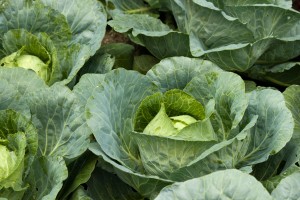Getting Ahead with Cabbages
Posted in Gardening Tips on October 4 2011, by Sonia Uyterhoeven
 We have all heard that ‘cabbage is king’ although I doubt many of us know why.
We have all heard that ‘cabbage is king’ although I doubt many of us know why.
It is certainly a stately vegetable, its elegant heads outshine all other vegetables in an ornamental vegetable garden. And in past centuries, it was a staple in many diets; it stores well and can easily feed a large family. It also had a reputation for ‘medicinal’ properties. Cabbage is high in vitamin C and fiber, has anti-inflammatory and anti-bacterial properties and historically was used as a cure for ulcers and cancer. But are these reasons for such a regal appellation?
I read on the news recently that a retired dentist, Steve Hubacek, won first place in the Alaska State Fair for the largest cabbage. His entry weighed 126 pounds and measured four feet tall and seven feet across. This year’s entry was just shy of the Guinness World Record, already held by Huacek, of 127 pounds.
I have no idea what you would do with all that cabbage, or if the mammoth beast would even taste good (World Record-holding pumpkins certainly do not). I like sauerkraut but that’s a lot of sauerkraut even if you stretch it out over six months (which is generally the length of time that you can keep homemade sauerkraut).
Even if you’re not planning to compete at the State Fair, you should still consider growing cabbage in your own garden.
Cabbages are a cool season crop and in the northeast the best time to plant is early spring, but it’s never too early to start planning ahead. Plant seedlings in your garden 3 to 4 weeks before your last frost date and then again in late-July/early-August for a late season crop. If you are starting them from seed, sow them several weeks earlier.
Cabbages are heavy feeders. Nitrogen promotes leaf growth and this leafy vegetable is a nitrogen lover. Nitrogen is the first number on your bag of fertilizer. I generally use an organic fertilizer on my vegetable garden such as Plant-tone® 5-3-3. Fertilizing every couple of weeks with a fish emulsion is also beneficial starting about three weeks after your transplant date. It is equally important to amend your soil on an annual basis with organic material such as compost and cow manure.
Cabbages like fertile well-drained soil, full sun (although they can handle part shade) and cooler temperatures. They like consistent moisture so mulching your beds with several inches of straw is always a good idea. If you subject your cabbages to extensive periods of drought they will most likely bolt and flower prematurely.
Space cabbage seedlings anywhere between 12 to 24 inches apart. The early varieties have smaller heads and can be spaced closely while some of the larger varieties occupy more space. Planting can influence the size of your cabbages; when you space them closer together they will produce smaller heads.
If you are troubled with cutworms in your garden make a cut worm collar for your seedlings out of a glossy magazine: cut a strip from the magazine, and wrap it around the base of the seedling before you plant it in the ground. Cabbage worms will munch holes into your leaves. You can either handpick these hungry little green caterpillars or use Bt (Bacillus thuringiensis) (see products such as Dipel®) You will know they are on their way when you see the white cabbage butterfly visiting your cabbages to lay their eggs.
Harvest your cabbage when the head is nice and firm. Sometimes your cabbage heads will split. This is common after a heavy rain when the heads take up too much moisture. If your cabbage head splits, harvest it immediately, cut off the split section, and use the rest.
Once you have beheaded your cabbage, if you leave a fair amount of the stem intact, small buds in the leaf axils will grow and form ‘cabbage sprouts’. Wait until they get firm and grow between 2 to 4 inches before harvesting. Cabbages can be stored for up to two weeks in the refrigerator. Late season varieties store well in root cellars.
Cabbages have a bad reputation because they stink if you overcook them. The antidote is simply not to overcook your cabbage. When they are subjected to long periods of cooking, a compound breaks down into sulfur and can emit an unpleasant odor. Aluminum pans exacerbate this problem, so cook with stainless steel. Red cabbage also has a habit of turning a gray blue color, you can avoid this by adding vinegar to the recipe.
Beginner gardeners are recommended to try fast maturing varieties such as ‘Dynamo’, ‘Early Jersey Wakefield’ (with its cone-shaped head), ‘Red Acre’, ‘Savoy Ace,’ or ‘Stonehead’.

